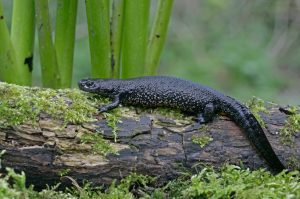
Female Great Crested Newt
The Great Crested Newt or Triturus cristatus is an amphibian in the family Salamandridae and the largest newt native to England. It is dark brown to black in colour with warty, rough skin and will reach 15-18cm at maturity. Its flanks will appear darker due to usually black spots and its underside is covered with a yellow or orange pattern unique to each animal. The males have a silver strip along the sides of their tails and in the spring will develop a jagged dorsal crest along their back and tail, with a noticeable divide or notch separating the two sections. The females have an orange strip along the sides of their tails and occasionally on top of the lower back and tail.
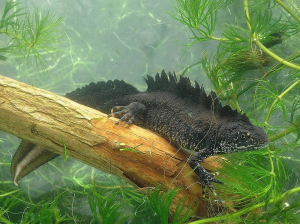
Male Great Crested Newt showing notch in crest
The notch in the crest of the male is the easiest way to distinguish between the Great Crested Newt and the Common Newt Lissotriton vulgaris, formerly classified as Triturus vulgaris.
These are primarily nocturnal creatures, preferring to take refuge during the day in damp, dark, frost free places usually under rocks, log piles or in crevices of man made materials. These damp and frost free places are also usually where they will hibernate during the winter but specimens have been noted to be active during this period, remaining in their pond. Depending on temperatures the newts will travel to ponds to mate in late February to early March where they will go through an elaborate mating ritual.
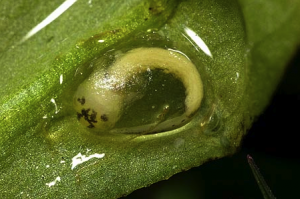
Great Crested Newt embryo
Their eggs are individually wrapped in plant leaves and will hatch after about three weeks. The larvae that emerge resemble fish fry, but they will quickly enlarge to the more recognisable juvenile form. They will then metamorphose into air-breathing juveniles about 4 months later and live above ground for two or three years until they reach sexual maturity.
How To Identify Habitats
Great Crested Newt Habitats will most likely be noticeable by the presence of a viable pond, however they have been known to travel over a kilometre from them and the body of water used may be hidden or unnoticed, for example roadside ditches have been known to house small populations.
Viable ponds usually have both submerged and aerial vegetation to provide both cover and to wrap eggs, they prefer medium sized ponds of a few hundred metres across. They do not require a high water quality but chemical pollution can be dangerous, and neutral pH usually results in the largest populations.
Ponds that lack shade on the south side are the most preferred but up to sixty percent shade cover is still ideal.
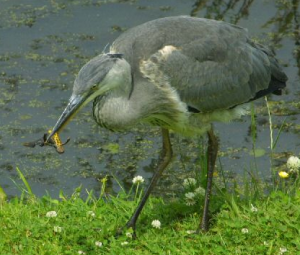
Great Crested Newt predation
Great Crested Newts are not generally found in ponds that support a fish population due to egg predation, they also tend to steer clear of ponds that support a large water fowl population, especially one that has been enlarged by human intervention, such as in parks where they are fed by passers by.
A good guide to how likely a pond will be to support Great Crested Newts can be found here
Also of importance is the terrestrial habitat; it will provide cover and foraging opportunities. These can range from meadow, rough grassland, hedges, scrub and occasionally woodland but a mixture is always preferable.
A licensed ecologist should be contracted to carry out any survey of whether there are any Great Crested Newts on the site, this is usually conducted as part of a Phase one habitat survey.
Legal Protection of the Great Crested Newt
The Great Crested Newt has been in decline for many years due to human intervention and has now received protected status; this is in order to prevent any further:
- Loss of ponds due to development, pollution, neglect and infilling
- Loss and fragmentation of terrestrial habitats
- Fish introduction to breeding ponds
- Decline of water quality due to pollution
- Direct loss of populations due to human interaction
The main acts protecting the Great Crested Newt in the United Kingdom are:
- The Wildlife and Countryside Act 1981 (as amended)
- Habitats [and Species] Directive (Council Directive 92/43/EEC of 21 May 1992 on the conservation of natural habitats and of wild fauna and flora)
- The CRoW Act 2000 also amends the Police and Criminal Evidence Act 1984 to render Section 9 offences ‘arrestable’, giving the police significant additional powers.
- Once captured Great Crested Newts may also fall under the Protection of Animals Act 1911, which prohibits cruelty and mistreatment.
- Improper release of the animals can also be prosecuted under the Abandonment of Animals Act 1960.
The great crested newt is listed on Schedule 5 of the 1981 Act, and is therefore subject to the provisions of Section 9, which make it an offence to:
- Intentionally kill, injure or take a great crested newt [Section 9(1)]
- Possess or control any live or dead specimen or anything derived from a great crested newt [Section 9(2)]
- Intentionally or recklessly damage, destroy or obstruct access to any structure or place used for
- Shelter or protection by a great crested newt [Section 9(4)(a)]
- Intentionally or recklessly disturb a great crested newt while it is occupying a structure or place which it uses for that purpose [Section 9(4)(b)]
- The European directive also covers them where they occur outside Special Areas of Conservation (SACs) by naming them specifically in Annex II and Annex IV. In schedule II regulation 39 makes it an offence to
- Deliberately capture or kill a great crested newt [Regulation 39(1)(a)]
- Deliberately disturb a great crested newt [Regulation 39(1)(b)]
- Deliberately take or destroy the eggs of a great crested newt [Regulation 39(1)(c)]
- Damage or destroy a breeding site or resting place of a great crested newt [Regulation 39(1)(d)]
The developer and their advisor(s) share the responsibility for the following:
-
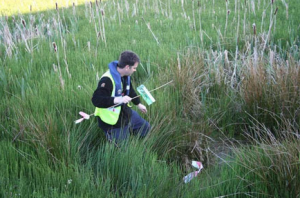
Great Crested Newt survey
Ensuring that they provide to Local Planning Authorities an accurate assessment of application sites, including surveys for great crested newts if their presence is suspected
- Applying for a licence to DEFRA should mitigation be required
- Providing a sound and objective assessment of the potential impact of proposed development on great crested newt populations
- Where necessary, designing and undertaking a mitigation scheme that meets planning and licensing requirements, and in particular will ensure as far as possible the long term future of any
- populations affected; such schemes should ideally employ ‘best practice’
- Where necessary, agreeing with Local Planning Authorities a Section 106 agreement or similar, to ensure continued support for affected populations
- In many cases, monitoring affected populations after completion of development
- it should be noted that the 1981 act covers unintentional harm where it could have been avoided, for instance by following the Natural England guidelines.
Mitigation Schemes
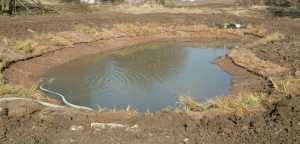
Habitat creation for Great Crested Newts
The main aspects of mitigation that may be required to be carried out:
- Habitat creation, restoration or enhancement – to provide receptor areas for displaced newts, in compensation for areas to be lost or damaged
- Avoidance of disturbance, killing or injury – taking all reasonable steps to ensure works do not harm individuals, by altering working methods or timing to avoid newts; capture and removal; exclusion to prevent newts entering development areas
- Long-term habitat management and maintenance – to ensure the population will persist
- Post-development population monitoring – to assess the success of the scheme and to inform management or remedial operations.

